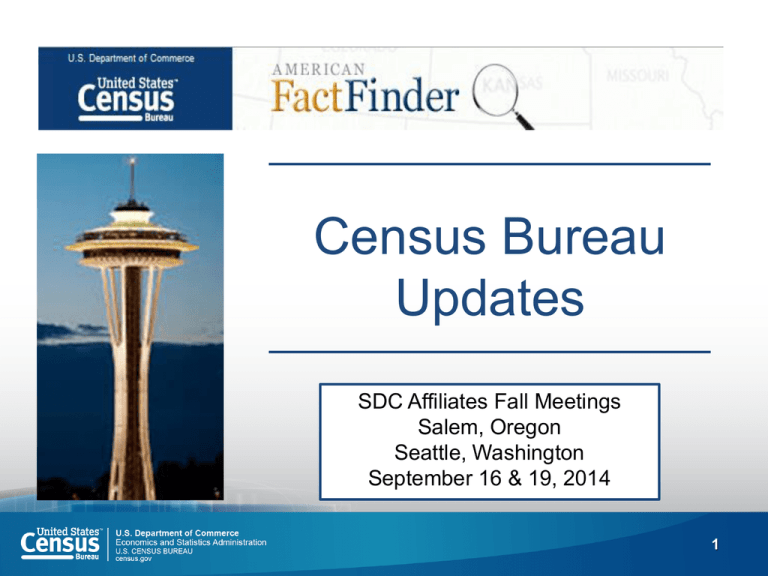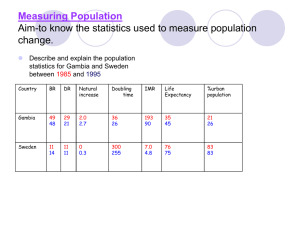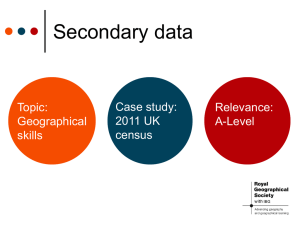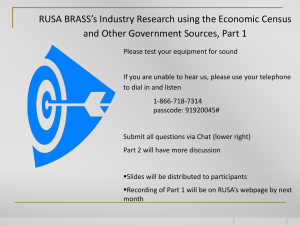
Census Bureau
Updates
SDC Affiliates Fall Meetings
Salem, Oregon
Seattle, Washington
September 16 & 19, 2014
1
Releases / Updates
American Community Survey
2020 Decennial Census
Data tools and apps
2
American Community Survey
3
Fall 2014 Releases
4
5
Data Product
Planed Release Date
Population Size of Area
2013 ACS 1-Year Estimates
September 18 , 2014
65,000 +
2011-2013 ACS 3-Year Estimates
October 23, 2014
20,000 +
2009-2013 ACS 5-Year Estimates
December 4, 2014
All Geographies
The American Community Survey is the only source of local statistics for
most of the 40 topics it covers - - such as education, occupation, language,
ancestry and housing costs - - for even the smallest communities.
6
7
7
Questionnaire Topics
American Community Survey (ACS)
Demographic
Sex
Age
Race
Ethnicity
Household
Relationship
Group
Quarters
Social
Families
Education
Marital Status
Fertility
Grandparent Caregivers
Veterans
Disability Status
Language at Home
Citizenship
Migration
Economic
Income
Poverty
Food Stamps / SNAP
Employment Status
Occupation
Industry
Journey to Work
Place of Work
Health Insurance
Housing
Tenure
Occupancy
Structure Housing
Value
Taxes / Insurance
Utilities
Mortgage
Monthly Rent
Vehicles
Items in red were also collected on the 2010 Census
8
Content Review
9
Information Gathering
Field Representative Survey: May 2014
• 1,063 responses from six Regional Offices and three
Contact Centers (representing 96.6% response rate
from 1,125 interviewers in sample)
• 6 questions concerning perceived intrusiveness,
burden, sensitivity for each item on the questionnaire
• 3 most “problematic” ACS questions based on
preliminary score and number of mentions
• Income – wages
• Type of Internet access
• Property value
10
Information Gathering
Data user feedback form: June-July
• Received 932 responses, representing 3,405 total
mentions of high-value or frequently-used
questions
• Most important or most frequently used ACS
questions
• How did this person usually get to work last week?
(457)
• What is the highest degree or level of school this
person has completed? (283)
• What was this person's total income during the past
12 months? (247)
11
Information Gathering
Advisory Committee Input: May-July
Working Group
• Kickoff held with Census Bureau May 8
• Met to review questions for value/burden to
stakeholder communities and to document example
uses
• Developed a report of their recommendations
• Presented results to NAC Committee August 6
Findings
Perceived intrusiveness and burden considered
Nearly all questions found to be of benefit to small
population groups and small geographic areas
12
Information Gathering
Federal agencies input: April-July
• Participation from 23 agencies representing
over 300 uses
• Majority of agencies reporting same number
or more uses over the OMB 2012 process
• Commerce OGC has made a strong
commitment to this project and is heavily
engaged in legal reviews of all the input to
provide the legal opinion on the statutory
basis for cited uses
13
Analysis
Analytic approach is determined
Methodology documentation is underway
Decision memo on business rules – 1st Draft
(June)
Decision memo on selection criteria – 1st Draft
(July)
Full methodological description with appendices
for each data input stream – 1st Draft (July)
To mitigate potential bias, criteria prespecified prior to review of data inputs
14
14
Next Steps
Develop recommendations from analysis: August
Report out findings: August - December
Federal Register notice (60 day comment period):
October - December
Vet responses received through Federal Register
notice: December
Make decisions that inform the OMB package:
December – January
Submit OMB package: Early Spring 2015
15
Content Review - Milestones
16
Current ACS Challenges
Issue
Congressional Discussion
Burden
Intrusiveness
Harassment
Defund or Eliminate Survey
Mandatory
Voluntary
Penalties
Reduce or Eliminate Survey
17
Issue: Mandatory vs. Voluntary
Respondent participation mandatory (current)
• Most respond on their own (59% self-response rate)
• Phone & field interviews boost overall response rate
(97.4%)
Impact of voluntary
• Testing found survey costs would increase by at least
$90 million annually
• Reduced quality due to (1) declines in participation
and (2) number of completed interviews (rather than
increase in survey errors)
• Inability to release estimates for small geographies
and small population subgroups
18
ACS Data Uses Project
19
What are we collecting?
Examples of how the ACS data are used
Subjects and geographic areas
Type of data user
Data product used
20
Why is it important to collect?
Based on the challenges, communicate better the
importance and utility of the ACS data to: (1) the public,
(2) congressional leaders, (3) local / state / federal
agencies, and (4) businesses, among others
Get a better understanding of the ways ACS data are used
Information can feed into the content review process
Information may impact our data products plan
Outreach messaging can be targeted for groups with
similar data needs/uses
21
How Will Information Be Used?
May request testimonials to support and validate
the ACS
• For educational or promotional purposes
• Organizations may be asked to do a video on how they
use ACS data
• Information requested by executives and Congress will
be readily available
22
ACS Improvements
23
Survey Improvements
Sample Reallocation
Objective: improve the reliability of the
estimates for small areas (under 20,000 population)
• Increased sampling rates for small tracts and
governmental units
• Slightly decreased sampling rates in larger tracts
Begun in January 2011
• First result: 2011-2015 ACS 5-year estimates, to
be released December 2016
24
Survey Improvements
ACS Sample Expansion
Sample expanded from 2.9 million to 3.54
million addresses per year
Sample increase began for
o Mailout in June 2011
o CATI in July 2011
o CAPI in August 2011
25
Survey Improvements
Expected Results
Five Year Coefficients of Variation (CVs) for typical tracts, by
size where red > yellow > green
CVs after
reallocation,
before sample
expansion
(2.9M)
CVs after
reallocation
and sample
expansion
(3.54M)
Tract Size
Category
Average
Tract Size
CVs before
reallocation
and sample
expansion
0 – 400
291
66%
41%
35%
401 – 1,000
766
41%
30%
25%
1,001 – 2,000
1,485
29%
29%
25%
2,000 – 4,000
2,636
26%
29%
25%
4,000 – 6,000
4,684
19%
29%
25%
6,000 +
8,337
15%
28%
25%
26
Survey Improvements
Internet Response Option
Ongoing digital transformation
61st U.S. Census Bureau survey with Internet
response option
Households in sample receive letter with login
instructions to secure website
Participants have the ability to review responses
Assistance available to respondents
Advantages
More convenient for respondents
More cost-effective
Secure and confidential
27
Available beginning 2013
https://respond.census.gov/acs
28
2020 Decennial Census
29
The Context
Census Cost per Housing Unit (2010$)
$200.00
$181
Rising costs of 2010 Census
largely driven by three factors:
(1) Declining self-response
rates requiring the hiring
of a large field staff
(2) Paper-based and laborintensive methods
requiring a large field
infrastructure
(3) Substantial investments
in major, national
updating of the address
frame just prior to the
enumeration (2009)
$180.00
$160.00
$140.00
$120.00
$108
$100.00
$80.00
$70
$60.00
$40
$40.00
$20.00
$29
$14
$0.00
1970
1980
1990
2000
2010 (estd) 2020 (proj)
(Projected cost for 2020 assumes no change in
design and past patterns of cost growth; also
includes the costs for American Community Survey)
30
Goals
The strategic outcome is to develop a design
which strikes a balance between delivering
the highest quality census while reducing
costs and managing risks.
The 2020 Census has four strategic goals:
•
•
•
•
An accurate and complete census
Embraced and valued results
An efficient census
A well-managed census
31
31
2014 Census Test
Where/When Is Test Being Conducted?
Approximately 190,000 housing units
• Part of Montgomery County, MD
• Part of Washington, DC
Temporary field office in Silver Spring, MD
End of June through September
• “Census Day” (reference date) was July 1, 2014
32
2014 Census Test
Overall Goals
Making decennial headcount quick, easy,
and safe for all to participate
Provide substantial taxpayer savings while
maintaining commitment to high quality
and accuracy
• Smart use of technology
• Use of existing government data sources
(administrative records)
33
2014 Census Test
Why These Locations?
Sites meet criteria for highly developed
(urban) areas near less developed areas
Size of sites provides efficient and cost
effective ways to test workloads
Sites’ proximity to Census Bureau
Headquarters in Suitland, MD allows for
easy, cost-effective observation
34
2014 Census Test
Why These Locations?
Subset* of non-responding households in
these two test sites will receive in-person
visits to test alternative field data collection
procedures
*In areas chosen based on demographic
factors that include the following . . .
35
2014 Census Test
Why These Locations?
Vacancy rates
Household size
2010 Census response rates
Mix of residences owned or rented, and
single- or multi-unit
Age of householders in area
Householder race and ethnicity
Availability of administrative records
36
2014 Census Test
What is the Census Bureau Testing?
Strategies to encourage householders to
respond via mail, Internet, and other
options (“self-response”)
Strategies to target in-person interviews to
more efficiently follow-up with households
that do not self-respond (“nonresponse
follow-up” or “NRFU”)
37
2014 Census Test
What Is the Scope of the Test?
Internet self-response mode and contact
strategies for Internet preregistration
E-mail and automated voice invitations
Mobile devices used by field staff to enumerate
non-responding households
Alternative NRFU contact strategies
Use of administrative records to identify cases to
remove from nonresponse workload
Use of adaptive design methodologies to manage
field enumerator work assignments
38
2014 Census Test
What’s on the Questionnaire?
Wording changes from 2010 Census
• Testing changes on race and Hispanic origin
questions, combining race and ethnicity into
one question
• Testing new response categories for opposite
sex and same-sex husband/wife/spouse and
unmarried partner relationships, both on the
Internet and on paper data collection
questionnaires
39
2014 Census Test
Will There Be Other Tests?
Additional testing activities planned for 2015
and subsequent years
• Plans still under development
• Will likely be conducted in different geographic
areas across the United States
40
2014 Census Test
Important Terms
Self-response
• Where households complete and return their
census questionnaire in a timely manner
(includes Internet response) – require no inperson follow-up visit
Administrative records
• Collected by government agencies to run or
administer a program (IRS, for example)
41
2014 Census Test
Will Results Be Released?
Test is designed to measure how well a
variety of new technologies and censustaking methods work
• Not designed to obtain a complete and
accurate count
• Official population counts will not be released
Test will support the critical research on
potential methods for the 2020 Census
42
Data Tools and Apps
43
Homepage: census.gov
44
Developers & Mobile Apps
Data Tab
45
Developers Page
46
Mobile Apps
Economic Indicators
47
Mobile Apps
Dwellr
48
Mobile Apps
Pop Quiz (of States)
49
Census Homepage: census.gov
QuickFacts
QuickFacts
Population threshold: 5,000
Geographies: State, county, place
Topics: Current demographic, business,
& geography facts, and links to historic
data (through “Browse data sets”)
50
census.gov > Data Tab > Data Tools and Apps
Census Explorer
51
Four Editions
Census Explorer
52
Census Explorer
Census Explorer (thematic maps)
Sources: 2012 American Community Survey 5-year
estimates, 2011 County Business Patterns, Census
2000, & 1990 Census
Geographies: U.S., state, county, census tract
Topics: Variety of demographic (currently 11) and
economic (currently 6) variables
53
census.gov > Data Tab > Data Tools and Apps
Easy Stats
54
Easy Stats
Easy Stats
Geographies: State, county, place
Topics: Financial, jobs, housing, people, education
-- all variables are crossed with race and ethnicity
55
Easy Stats
56
American FactFinder (AFF): factfinder2.census.gov
Census Homepage: census.gov
57
factfinder2.census.gov
American FactFinder (AFF)
58
Help
American FactFinder
59
Assistance with AFF
• Click Help (AFF mainpage, top right)
•
•
•
•
•
•
•
•
•
•
•
•
Online User Guide
Virtual Tour
Community Facts
Guided Search
Advanced Search
Download Options
Using Data
Tables
Maps
Narrative Profiles
Tutorials
Glossary
60
Community Facts
American FactFinder (AFF)
Community Facts tab
61
factfinder2.census.gov
American FactFinder (AFF)
Community Facts tab
62
AFF Community Facts
Each of the 10 filter bars
presents a single variable for
the selected geography, as
well as links to additional
tables for the same topic and
the same geographic area
63
factfinder2.census.gov
American FactFinder (AFF)
Guided Search tab
64
Recommended for Novice Data Users
AFF Guided Search
User answers prompts,
then clicks “Next” or a
numbered arrow to
proceed -- arrows 1
through 4 may be
selected in any order
65
factfinder2.census.gov
American FactFinder (AFF)
Advanced Search tab
66
AFF Advanced Search
Filter bars facilitate searches. Object is to select filters, such
as Topics, to refine search. All filters will appear in the Your
Selections box to be applied to the final table selection.
67
Topics Filter Bar
68
“People” Menu Expanded
69
Product Type = Table Format
See page 8 of the Quick
Reference Guide for full
descriptions of product types
70
Census Programs on AFF
Alphabetical listing of all
programs loaded on
American FactFinder
71
Datasets on AFF
Latest release is at the
top of the list
72
Key Word Search
73
census.gov Footer
Census & ACS Questionnaires
74
census.gov Footer > About Us > History
Census Questionnaires
75
Census Questionnaires Archive
76
census.gov Footer > People & Households > ACS
ACS Questionnaires
77
Workshop Information
and
Data Questions
Linda Clark
Data Dissemination Specialist
Pacific Northwest & Alaska
U.S. Census Bureau
Los Angeles Region
linda.clark@census.gov
Mobile: 206-446-8794
Los Angeles Regional Office
818-267-1725
or
888-806-6389 (toll-free )
78








